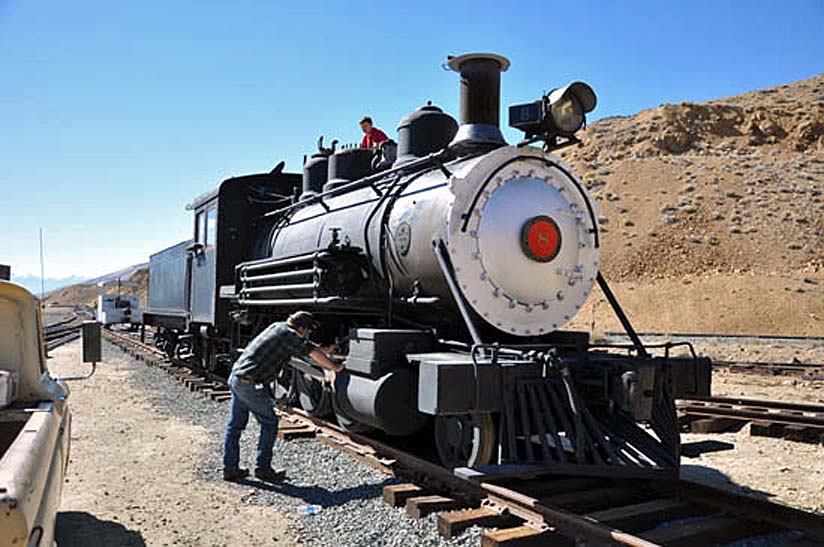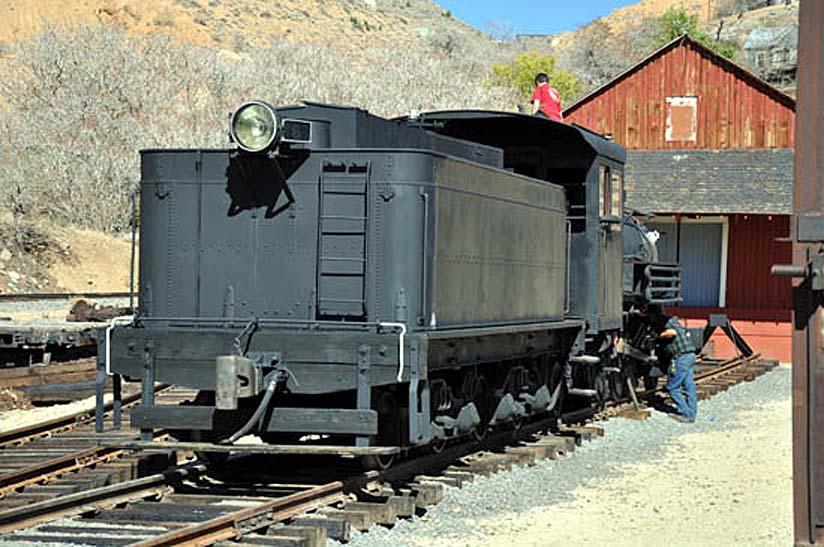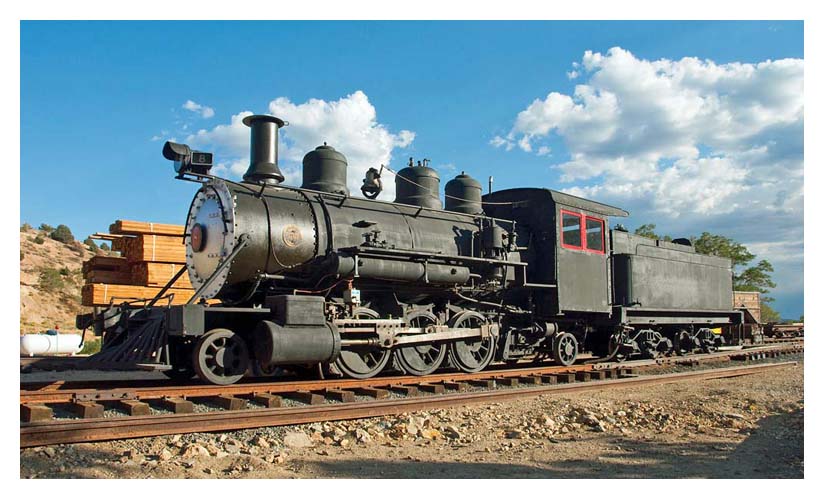
Gold Hill Nevada - The Gold Hill Historical Society (GHHS) was named the physical custodial agent for steam locomotive Number 8, owned by the Feather River Short Line Railroad. This locomotive was moved to the Gold Hill site in February 2009 where it is being protected. It is stored on a lead track that connects with the existing Virginia & Truckee Railroad, with the intention of supporting operations of that railroad, and its extended reconstruction currently in progress, for special events, and potentially as a backup in the event of mechanical failure of equipment owned by other parties.
Locomotive Number 8 is a Baldwin 2-6-2 Prairie, builder's number 32160, built in November of 1907 and sold to the Sierra Nevada Wood and Lumber Company, Hobart Mills, California. This company became the Hobart Estate Co. in 1917. Since the company's lines into the woods were narrow gauge, the engine was used on the Company's standard gauge connection between Hobart Mills and Truckee until 1937. This connection became known as the Hobart Southern in 1932. In August 1938, Number 8 was sold to the Clover Valley Lumber Co. of Loyalton, California, and was used as a woods switcher by them.
Some time after 1938, it changed ownership again, this time to the Feather River Lumber Company. It was retired from the Feather River Lumber Company on 30 Nov 1956. It was then donated to the non-profit Plumas County Fair Association in the spring of 1958, with the intention of putting it on static display at the Quincy Fairgrounds in California.
The Fair Association lacked the funds to move Number 8 from Loyalton to the Fairgrounds at Quincy. The Fair Association arranged with the Quincy Railroad Company to move the locomotive under its own power over the eight miles of track from Quincy Junction to Quincy on 28 Mar 1958. It was placed on the Quincy Railroad siding where the last inspection report was recorded on 31 Mar 1958.
The Feather River Short Line Railroad (FRSL) was organized as a non-profit corporation at the instigation of the Plumas County Fair Association. The purpose of the FRSL was to preserve and display the locomotive, and initially to raise enough money to move the locomotive to the fairgrounds from the siding.

Fund raising was slow, and the locomotive remained on the siding until 19 May 1962. The secretary of the Northern California Railroad Historical Society arranged with the Fair Association and the FRSL to make Number 8 operational and to move from Quincy to Quincy Junction and back under steam. Jimmy Boynton was the engineer and William Dessert was the fireman. This movement was being conducted as part of an excursion arranged by the Western Pacific Railroad, which included a six mile steam run by Quincy Railroad's locomotive Number 2, for which a nominal fare of one dollar was charged. The passengers were accommodated on benches put atop four gondola cars provided by the Western Pacific. Jimmy Boynton was an engineer with the Western Pacific at the time of the excursion (but was not paid for his operation of Number 8 that day). At one point in the excursion, Quincy Railroad Number 2 and FRSL Number 8 double-headed the consist of four gondola cars for about 300 feet for purposes of allowing photographs to be made by the excursionists.
The funds raised by this excursion and by earlier fund-raising efforts were sufficient to allow a temporary track to be built to the fairgrounds and Number 8 was moved there at the end of March, 1962. An observer at the 19 May 1962 excursion filed a complaint that caused the United States Federal Railway Administration to file a complaint against the Quincy Railroad Company on 26 Dec 1962 asking that a US$250 penalty be imposed.
The Quincy Railroad Company prevailed at trial, and prevailed on appeal. The theory of the complaint was that Number 8 was operated with an expired inspection certificate, on a line that was a common carrier or otherwise regulated by the Interstate Commerce Commission. However, it was not used by the Quincy Railroad Company per se, even though it did run over its line. It was this last technicality upon which the appeals court found in favor of the defendant (the Railroad).
But, this case was critical in putting the owners of the locomotive, the FRSL, on notice that they could not operate in the future over rails belonging to a regulated railroad. The United States of America vs. Quincy Railroad Company, United States Court of Appeals Ninth Circuit, 18 Nov 1964.
After that time, the FRSL looked for opportunities to run over private right-of-ways. It was eventually moved to the Portola Railroad Museum and operated there.
Jimmy Boynton passed away around 1993 (date uncertain) and his wife took over as the primary decision-maker as to the operation of the Number 8. Some time thereafter a lease agreement was entered into between the Virginia & Truckee Railroad and the FRSL. The lease provided for Number 8's continued operation, maintenance, and therefore certification. In the late 1990s, the FRA inspector insisted that Number 8 undergo extensive repairs prior to re-certification, based primarily on age, and not any obvious defect.
About 2006 the FRSL threatened litigation to either repair, certify, and operate the locomotive, or to return it to the FRSL.
A test coupon cut from the firebox walls showed that almost no corrosion at all could be seen. The boiler was completely sound. The locomotive was re-assembled in August and September of 2008 and the V&T consented to return it to the FRSL.
The FRSL arranged with Storey County to store the locomotive on county property at Gold Hill. The Gold Hill Historical Society agreed to construct a house track and/or a team track, connected to the V&T, onto which the locomotive could be placed and preserved.
Author unknown.

(because there was no image with original article)
*2. Original news article image replaced.
(because it was a poor photo)
provisions in Section 29 of the Canadian
Copyright Modernization Act.

